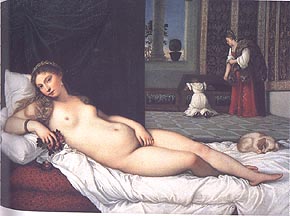Genesis, 1: 26: Let us make man to our image and likeness: and
let him have dominion over the fishes of the sea, and the fowls
of the air, and the beasts, and the whole earth, and every creeping
creature that moveth upon the earth. 2:7: And the Lord God formed
man of the slime of the earth: and breathed into his face the
breath of life, and man became a living soul.
Baldesar Castiglione, The Book of the Courtier, Book III, 15 (p. 217): "...I will say only that in the opinion of very wise men, as you know, man is as the form and the woman as the matter; and therefore, just as the form is more perfect than the matter-- nay, gives it its being-- so man is far more perfect than woman."
John Berger, Ways of Seeing, p. 47: One might simplify this by saying: men act and women appear. Men look at women. Women watch themselves being looked at. This determines not only most relations between men and women but also the relation of women to themselves. The surveyor of woman in herself is male: the surveyed female. Thus she turns herself into an object -- and most particularly an object of vision: a sight.
 |
 |
| Michelangelo, Creation of Adam, from the Sistine Ceiling, 1508-1512. | Titian, Venus of Urbino, 1538. |
A central tenet of contemporary critical theory is that gender roles are socially constructed. These two images can be seen as significant statements in the construction of gender. Contrast the gender identities represented by these images. Relate the contrast between these images to the following quotation from John Berger's Way of Seeing: "...men act and women appear. Men look at women. Women watch themselves being looked at. This determines not only most relations between men and women but also the relation of women to themselves. The surveyor of woman in herself is male: the surveyed female. Thus she turns herself into an object -- and most particularly an object of vision: a sight." Note difference in style between these images.